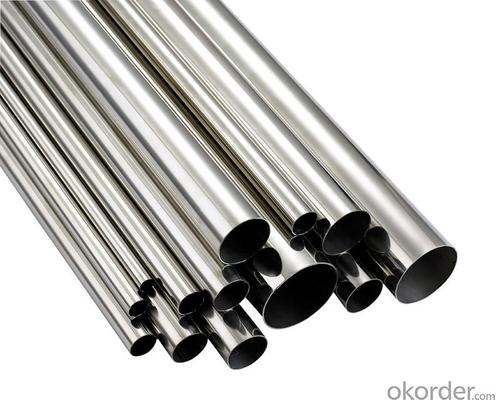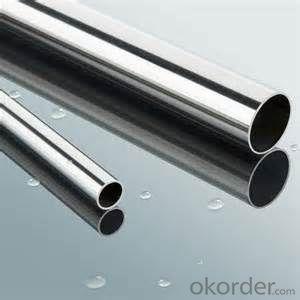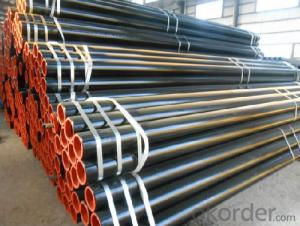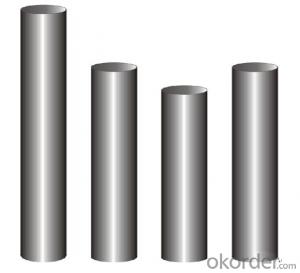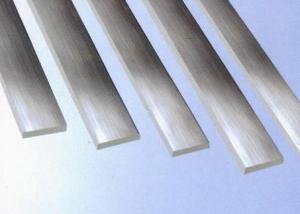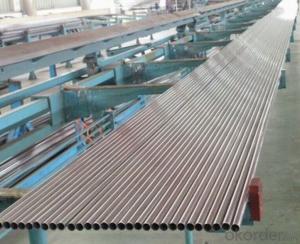STAINLESS STEEL PIPES 304L 316L materail
- Loading Port:
- China Main Port
- Payment Terms:
- TT OR LC
- Min Order Qty:
- -
- Supply Capability:
- -
OKorder Service Pledge
OKorder Financial Service
You Might Also Like
Description:
Stainless Steel Pipe
Material:
304 321 316 310
Packing:
In bundle
MOQ:
5 TONS
Comparison of standardized steels
| EN-standard Steel no. k.h.s DIN | EN-standard Steel name | SAE grade | UNS |
|---|---|---|---|
| 1.4109 | X65CrMo14 | 440A | S44002 |
| 1.4112 | X90CrMoV18 | 440B | S44003 |
| 1.4125 | X105CrMo17 | 440C | S44004 |
| | | 440F | S44020 |
| 1.4016 | X6Cr17 | 430 | S43000 |
| 1.4408 | G-X 6 CrNiMo 18-10 | 316 | |
| 1.4512 | X6CrTi12 | 409 | S40900 |
| | | 410 | S41000 |
| 1.4310 | X10CrNi18-8 | 301 | S30100 |
| 1.4318 | X2CrNiN18-7 | 301LN | |
| 1.4307 | X2CrNi18-9 | 304L | S30403 |
| 1.4306 | X2CrNi19-11 | 304L | S30403 |
| 1.4311 | X2CrNiN18-10 | 304LN | S30453 |
| 1.4301 | X5CrNi18-10 | 304 | S30400 |
| 1.4948 | X6CrNi18-11 | 304H | S30409 |
| 1.4303 | X5CrNi18-12 | 305 | S30500 |
| | X5CrNi30-9 | 312 | |
| 1.4541 | X6CrNiTi18-10 | 321 | S32100 |
| 1.4878 | X12CrNiTi18-9 | 321H | S32109 |
| 1.4404 | X2CrNiMo17-12-2 | 316L | S31603 |
| 1.4401 | X5CrNiMo17-12-2 | 316 | S31600 |
| 1.4406 | X2CrNiMoN17-12-2 | 316LN | S31653 |
| 1.4432 | X2CrNiMo17-12-3 | 316L | S31603 |
| 1.4435 | X2CrNiMo18-14-3 | 316L | S31603 |
| 1.4436 | X3CrNiMo17-13-3 | 316 | S31600 |
| 1.4571 | X6CrNiMoTi17-12-2 | 316Ti | S31635 |
| 1.4429 | X2CrNiMoN17-13-3 | 316LN | S31653 |
| 1.4438 | X2CrNiMo18-15-4 | 317L | S31703 |
| 1.4362 | X2CrNi23-4 | 2304 | S32304 |
| 1.4462 | X2CrNiMoN22-5-3 | 2205 | S31803/S32205 |
| 1.4539 | X1NiCrMoCu25-20-5 | 904L | N08904 |
| 1.4529 | X1NiCrMoCuN25-20-7 | | N08926 |
| 1.4547 | X1CrNiMoCuN20-18-7 | 254SMO | S31254 |
Stainless steel’s resistance to corrosion and staining, low maintenance and familiar lustre make it an ideal material for many applications. There are over 150 grades of stainless steel, of which fifteen are most commonly used. The alloy is milled into coils, sheets, plates, bars, wire, and tubing to be used in cookware, cutlery, household hardware, surgical instruments, major appliances, industrial equipment (for example, in sugar refineries) and as an automotive and aerospace structural alloy and construction material in large buildings. Storage tanks and tankers used to transport orange juice and other food are often made of stainless steel, because of its corrosion resistance. This also influences its use in commercial kitchens and food processing plants, as it can be steam-cleaned and sterilized and does not need paint or other surface finishes.
Stainless steel is used for jewelry and watches with 316L being the type commonly used for such applications. It can be re-finished by any jeweler and will not oxidize or turn black.
Some firearms incorporate stainless steel components as an alternative to blued or parkerized steel. Some handgun models, such as the Smith & Wesson Model 60 and the Colt M1911 pistol, can be made entirely from stainless steel. This gives a high-luster finish similar in appearance to nickel plating. Unlike plating, the finish is not subject to flaking, peeling, wear-off from rubbing (as when repeatedly removed from a holster), or rust when scratched.
Architecture[edit]
Stainless steel is used for buildings for both practical and aesthetic reasons. Stainless steel was in vogue during the art deco period. The most famous example of this is the upper portion of the Chrysler Building (pictured). Some diners and fast-food restaurants use large ornamental panels and stainless fixtures and furniture. Because of the durability of the material, many of these buildings retain their original appearance.
Type 316 stainless is used on the exterior of both the Petronas Twin Towers and the Jin Mao Building, two of the world's tallest skyscrapers.[17]
The Parliament House of Australia in Canberra has a stainless steel flagpole weighing over 220 tonnes (240 short tons).
The aeration building in the Edmonton Composting Facility, the size of 14 hockey rinks, is the largest stainless steel building in North America.
Bridges[edit]
Cala Galdana Bridge in Minorca (Spain) was the first stainless steel road bridge.
Sant Fruitos Pedestrian Bridge (Catalonia, Spain), arch pedestrian bridge.
Padre Arrupe Bridge (Bilbao, Spain) links the Guggenheim museum to the University of Deusto.[18]
Monuments and sculptures[edit]
The Unisphere, constructed as the theme symbol of the 1964-5 World's Fair in New York City, is constructed of Type 304L stainless steel as a sphere with a diameter of 120 feet, or 36.57 meters.
The Gateway Arch (pictured) is clad entirely in stainless steel: 886 tons (804 metric tonnes) of 0.25 in (6.4 mm) plate, #3 finish, type 304 stainless steel.[19]
The United States Air Force Memorial has an austenitic stainless steel structural skin.
The Atomium in Brussels, Belgium was renovated with stainless-steel cladding in a renovation completed in 2006; previously the spheres and tubes of the structure were clad in aluminium.
The Cloud Gate sculpture by Anish Kapoor, in Chicago US.
The Sibelius monument in Helsinki, Finland, is made entirely of stainless steel tubes.
The Man of Steel (sculpture) under construction in Rotherham, England.
Other[edit]
- Automotive bodies
The Allegheny Ludlum Corporation worked with Ford on various concept cars with stainless steel bodies from the 1930s through the 1970s, as demonstrations of the material's potential. The 1957 and 1958 Cadillac Eldorado Brougham had a stainless steel roof. In 1981 and 1982, the DeLorean DMC-12 production automobile used stainless steel body panels over a glass-reinforced plasticmonocoque. Intercity buses made by Motor Coach Industries are partially made of stainless steel. The aft body panel of the Porsche Cayman model (2-door coupe hatchback) is made of stainless steel. It was discovered during early body prototyping that conventional steel could not be formed without cracking (due to the many curves and angles in that automobile). Thus, Porsche was forced to use stainless steel on the Cayman.
- Passenger rail cars
Rail cars have commonly been manufactured using corrugated stainless steel panels (for additional structural strength). This was particularly popular during the 1960s and 1970s, but has since declined. One notable example was the early Pioneer Zephyr. Notable former manufacturers of stainless steel rolling stock included the Budd Company (USA), which has been licensed to Japan's Tokyu Car Corporation, and the Portuguese company Sorefame. Many railcars in the United States are still manufactured with stainless steel, unlike other countries who have shifted away.
- Aircraft
Budd also built an airplane, the Budd BB-1 Pioneer, of stainless steel tube and sheet, which is on display at the Franklin Institute.
The American Fleetwings Sea Birdamphibious aircraft of 1936 was also built using a spot-welded stainless steel hull.
The Bristol Aeroplane Company built the all-stainless steel Bristol 188 high-speed research aircraft, which first flew in 1963.
The use of stainless steel in mainstream aircraft is hindered by its excessive weight compared to other materials, such as aluminum.
- Jewelry
Valadium, a stainless steel and 12% nickel alloy is used to make class and military rings. Valadium is usually silver-toned, but can be electro-charged to give it a gold tone. The gold tone variety is known as Sun-lite Valadium
- Q: What is the difference between 304Ti and 316Ti stainless steel pipes?
- 304Ti and 316Ti are both types of stainless steel pipes, but they have some key differences. The main difference between 304Ti and 316Ti stainless steel pipes lies in their chemical composition. 304Ti is a variant of the 304 stainless steel grade, while 316Ti is a variant of the 316 stainless steel grade. One of the major distinctions is the presence of molybdenum in 316Ti, which is absent in 304Ti. Molybdenum enhances the corrosion resistance of stainless steel, making 316Ti more resistant to pitting and crevice corrosion in chloride-containing environments, such as marine or coastal areas. This makes 316Ti a preferred choice for applications where exposure to corrosive elements is a concern. Additionally, the carbon content in 316Ti is lower than that in 304Ti, which improves its resistance to sensitization and intergranular corrosion. Sensitization occurs when stainless steel is exposed to high temperatures, leading to the formation of chromium carbides, which can reduce the corrosion resistance of the material. By reducing the carbon content, 316Ti minimizes the risk of sensitization and maintains its corrosion resistance even under high-temperature conditions. In terms of mechanical properties, 316Ti generally has higher tensile strength and yield strength compared to 304Ti, making it more suitable for applications that require higher strength and durability. However, it is important to note that both grades of stainless steel pipes have excellent strength and toughness. In summary, the main differences between 304Ti and 316Ti stainless steel pipes lie in their chemical compositions and resulting corrosion resistance. 316Ti offers superior corrosion resistance in chloride-containing environments and better resistance to sensitization and intergranular corrosion. However, the choice between the two grades ultimately depends on the specific application requirements and environmental factors.
- Q: Are stainless steel pipes resistant to hydrogen embrittlement?
- Generally, stainless steel pipes are resistant to hydrogen embrittlement. Hydrogen embrittlement refers to the phenomenon where hydrogen can penetrate certain metals, making them brittle and prone to cracking or failure. Stainless steel, on the other hand, possesses a high resistance to hydrogen embrittlement due to its unique composition. It primarily consists of iron, chromium, and other alloying elements like nickel and molybdenum. The chromium in stainless steel forms a passive oxide layer on the surface, which offers excellent corrosion resistance and acts as a barrier against hydrogen diffusion. Moreover, stainless steel pipes are often made using specific grades, such as austenitic or duplex stainless steels, which exhibit even greater resistance to hydrogen embrittlement. These grades contain higher amounts of alloying elements, further enhancing their ability to resist hydrogen attack. However, it is important to acknowledge that stainless steel can still be vulnerable to hydrogen embrittlement under certain conditions, such as high temperatures and high-pressure environments. Therefore, it is crucial to carefully consider the specific application and operating conditions when selecting stainless steel pipes to ensure their resistance to hydrogen embrittlement.
- Q: Can stainless steel pipes be used for oil and gas transportation?
- Indeed, the utilization of stainless steel pipes for the transportation of oil and gas is plausible. Due to its exceptional resistance to corrosion and durability, stainless steel has become a favored material choice within the oil and gas industry for pipe construction. These pipes possess the capability to endure harsh circumstances, including high pressure, extreme temperatures, and corrosive surroundings, rendering them appropriate for the conveyance of oil and gas. Furthermore, the purity of the transported fluids is maintained by stainless steel pipes, as they exhibit no reactivity or contamination towards the substances being conveyed. As a result, stainless steel pipes are an unquestionably dependable and efficient option for oil and gas transportation.
- Q: What is the difference between Type 304L and Type 316L stainless steel pipes?
- Type 304L and Type 316L stainless steel pipes are commonly chosen for a variety of uses due to their ability to resist corrosion. However, they differ in their composition and performance in specific settings. The primary distinction lies in their alloy content. Type 304L stainless steel contains 18-20% chromium and 8-12% nickel, whereas Type 316L stainless steel contains 16-18% chromium, 10-14% nickel, and 2-3% molybdenum. The inclusion of molybdenum in Type 316L enhances its corrosion resistance, particularly in environments with high chloride concentrations. As a result, Type 316L is more suitable for applications where the pipes will come into contact with seawater, brine, or other harsh chemicals. Another factor that sets them apart is their mechanical properties. Type 316L stainless steel has slightly higher tensile strength and yield strength compared to Type 304L. It also exhibits better creep and stress rupture properties, making it more appropriate for high-temperature uses. However, for most general purposes, Type 304L is still a good choice, offering excellent durability and longevity. When it comes to cost, Type 316L stainless steel pipes are typically more expensive than Type 304L due to the additional alloying elements. Therefore, the decision between the two will depend on the specific requirements of the application, taking into account factors such as the corrosive environment, temperature, and budget. Overall, while both Type 304L and Type 316L stainless steel pipes provide excellent corrosion resistance, Type 316L offers superior performance in more aggressive environments and higher temperatures. It is advisable to consult with a materials expert or engineer to determine the most suitable stainless steel pipe for a particular application.
- Q: What is the difference between 409 and 316 stainless steel pipes?
- The composition and intended use are what differentiate 409 and 316 stainless steel pipes. 409 stainless steel is categorized as ferritic stainless steel, containing more chromium but less nickel than 316 stainless steel. This means that 409 stainless steel is less resistant to corrosion and oxidation. However, it is still suitable for applications that require moderate levels of corrosion resistance, such as automotive exhaust systems and heat exchangers. On the contrary, 316 stainless steel is classified as austenitic stainless steel, with higher amounts of both chromium and nickel. Because of its composition, it provides excellent corrosion resistance, even in demanding environments. Therefore, it is commonly used in applications where superior resistance to corrosion is necessary, such as marine environments, chemical processing plants, and medical equipment. To summarize, the main distinctions between 409 and 316 stainless steel pipes are their composition and corrosion resistance. 409 stainless steel is appropriate for applications with moderate levels of corrosion resistance, while 316 stainless steel is the preferred choice for applications that demand superior corrosion resistance in harsh environments.
- Q: What is the cost of stainless steel pipes?
- The cost of stainless steel pipes can vary based on factors such as the size, grade, and quantity needed. It is best to contact a supplier or manufacturer for specific pricing information.
- Q: What is the corrosion resistance of stainless steel pipes?
- Stainless steel pipes have excellent corrosion resistance due to the presence of chromium in their composition, which forms a protective oxide layer on the surface. This oxide layer acts as a barrier, preventing the metal from coming into contact with corrosive materials and environments. As a result, stainless steel pipes are highly resistant to corrosion, making them suitable for various applications in industries such as oil and gas, chemical processing, and marine environments.
- Q: What is the difference between 201 and 316 stainless steel pipes?
- The main difference between 201 and 316 stainless steel pipes lies in their chemical composition and respective properties. 201 stainless steel is a lower grade of stainless steel compared to 316. It contains a higher amount of manganese and nitrogen, which gives it improved strength and corrosion resistance compared to other lower grade stainless steels. However, it is not as durable as 316 stainless steel and is more prone to corrosion and rusting. On the other hand, 316 stainless steel is a high-quality grade that contains a higher percentage of chromium and nickel. These elements enhance its corrosion resistance, making it highly resistant to pitting and crevice corrosion, especially in chloride environments. 316 stainless steel pipes are also more resistant to high temperatures and have superior strength compared to 201 stainless steel pipes. Therefore, 316 stainless steel pipes are widely used in industries with demanding requirements such as marine, chemical, and medical sectors, where corrosion resistance and durability are crucial. 201 stainless steel pipes, while suitable for general applications, are more commonly used in less demanding environments where cost-effectiveness is a priority.
- Q: Can stainless steel pipes be insulated with polyethylene naphthalate?
- No, stainless steel pipes cannot be insulated with polyethylene naphthalate.
- Q: What are the different types of stainless steel pipe valves?
- Various stainless steel pipe valves are available, each serving specific purposes and industries. Some commonly utilized types include: 1. Ball valves: These valves control fluid flow with a rotating ball featuring a central hole. They possess excellent sealing capabilities, making them suitable for high-pressure applications. 2. Gate valves: Flow control is achieved through a sliding gate in gate valves. They are commonly employed in situations that require a straight-line flow with minimal pressure drop. 3. Globe valves: Globe valves consist of a spherical body and a regulating disc that moves vertically. They offer effective throttling abilities and are often utilized in applications that demand precise fluid flow control. 4. Check valves: These valves permit fluid to flow in only one direction and prevent backflow. They are frequently installed in piping systems to prevent damage caused by reverse flow. 5. Butterfly valves: Butterfly valves utilize a rotating disc within the pipe to regulate flow. Their lightweight, compact nature and cost-effectiveness make them suitable for a wide array of applications. 6. Needle valves: Needle valves possess a slender, tapered stem that allows for precise control over flow rates. They are commonly found in applications that necessitate accurate flow regulation, such as laboratory or instrumentation systems. 7. Pressure relief valves: These valves automatically release excess pressure from a system when it surpasses a certain threshold. They are crucial for maintaining the safety and integrity of piping systems. These examples represent only a fraction of the stainless steel pipe valves available. The choice of valve depends on factors such as fluid type, pressure, temperature, and specific application requirements. It is important to consult with a valve expert or engineer to select the most suitable valve for your specific needs.
Send your message to us
STAINLESS STEEL PIPES 304L 316L materail
- Loading Port:
- China Main Port
- Payment Terms:
- TT OR LC
- Min Order Qty:
- -
- Supply Capability:
- -
OKorder Service Pledge
OKorder Financial Service
Similar products
Hot products
Hot Searches
Related keywords

